The Future of Remote Work

Key highlights
- The share of fully remote or hybrid job postings in Western developed markets remains at levels significantly higher than prior to the Covid-19 pandemic, but is beginning to level off.
- The share of fully remote or hybrid job postings for information and technology related functions, requiring highly skilled workers, is still growing and will remain robust in the near future.
- Organisations with larger workforces tend to offer more fully remote or hybrid work.
Covid-19 and remote work
A paper published in March in the US National Bureau of Economic Research (NBER) charts the major trends in remote work, comparing the situation in the pre-pandemic labour market to the post-pandemic scenario, by analysing 250 million job vacancy postings across five English-speaking developed economies.
The first broad and unsurprising finding is that although remote working existed before the Covid-19 pandemic, its share in the overall job market was quite low compared to now. In 2019, the share of job postings offering remote or hybrid work ranged between 1% and 4% in these five economies. At the end of 2022, this range was 10% to 18%. This suggests that, on average, the availability of remote jobs increased seven times in this three-year period. The data also show that while the US was the leading country in terms of remote work prevalence pre-Covid, the UK has by now outstripped the other four. One key differentiating factor here may be the severity and duration of lockdowns during the pandemic, and as discussed below, the size and population density of major urban centres.
Figure 1: Share of Hybrid or Fully Remote Job Postings by Country
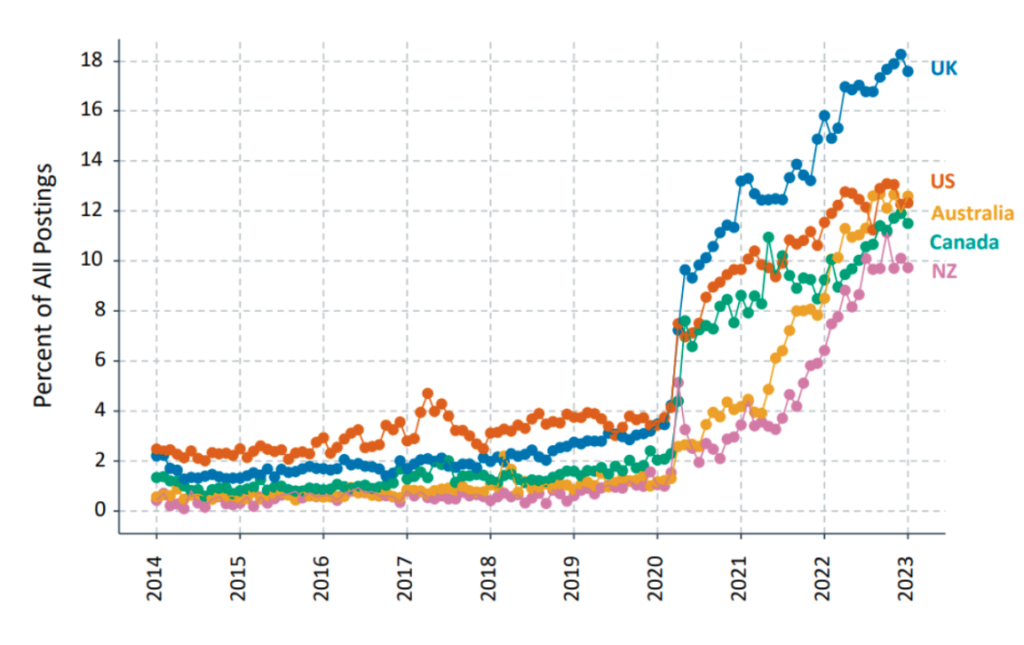
Another important aspect that the study looked at is how remote work has fared in different industries. Overall, jobs that can broadly be clubbed into ‘knowledge work’ have proven to be the most amenable to remote working. In terms of the share of remote work opportunities, computer-related and mathematical jobs saw the highest increase, being 5.4 times higher in 2022 compared to 2019. For architecture and engineering this was 5.1 times, followed by business and finance (3.9 times), management (3.5 times), and art and design (3.4 times).
Figure 2: Change in Share of Hybrid or Fully Remote Postings by Job Function
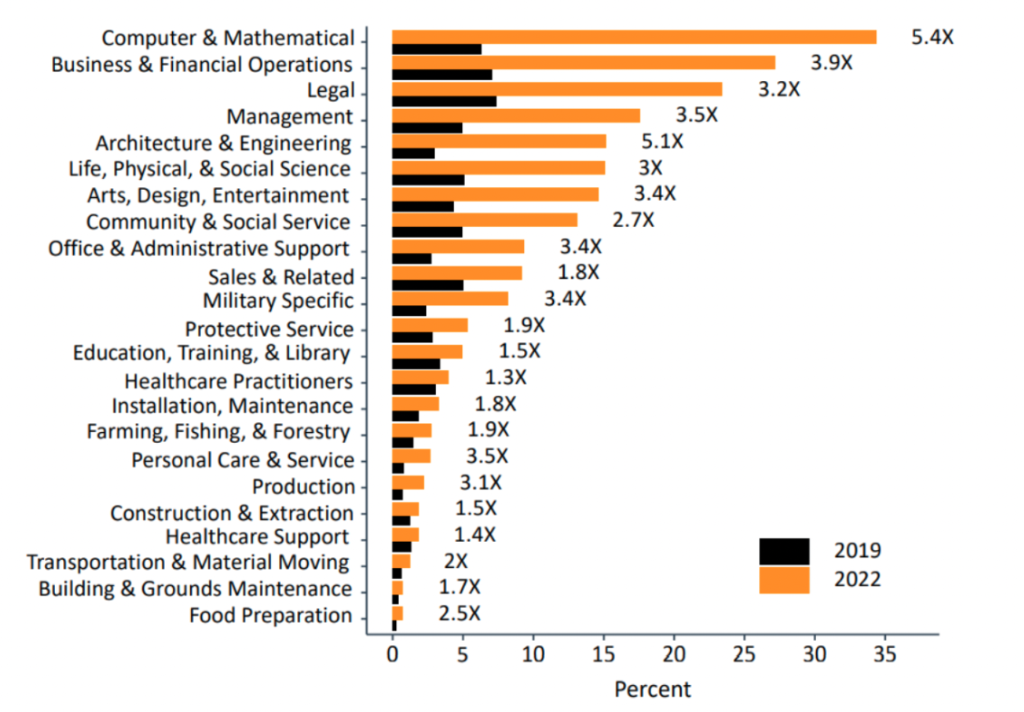
In addition to differences between countries, there is variation in the preponderance of remote work across cities within a country. In the UK, Australia, and Canada, the most populous city also had the highest increase in the share of remote vacancies; London, Sydney, and Toronto respectively. In the US, after DC, the biggest increase was observed in San Francisco, likely because of that city being the hub of the technology sector in the country. These findings support the expectation that larger cities are likely to see a greater prevalence of remote work, since they are home to relatively higher numbers of knowledge workers whom as we saw above, are more likely to be offered remote jobs.
Figure 3: Share of Hybrid or Fully Remote Job Postings by Major Cities
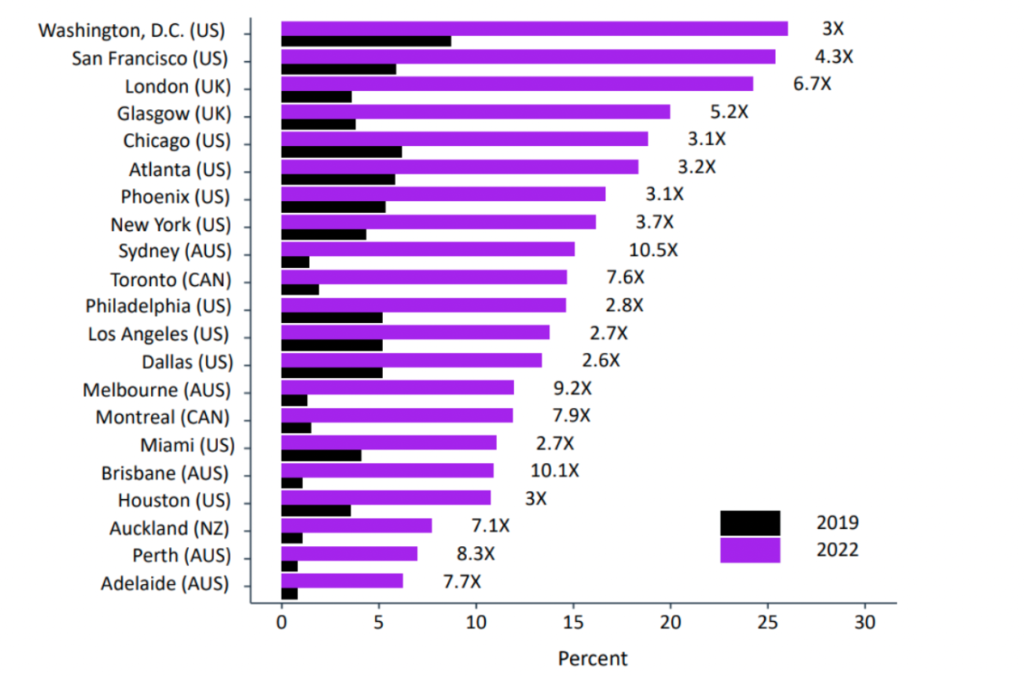
Remote work is here to stay
Given that the adoption of remote work has been broad-based both geographically and across various industries, the key question for the future is whether this trend will be sustained or reversed, as many companies try to get workers back into offices. To try to answer this question, we again turned to actual labour market data, and analysed recent findings from the US, Europe, and Australia published by a large online jobs platform.
United States
Turning first to the US, the headline finding is that the proportion of remote or hybrid work postings has declined since 2022, but still remains high. From a peak of around 10% in early 2022, it had slowly but steadily declined to 8.4% by April 2023. This is partly due to the fact that once the transmission of Covid-19 was brought under control, by the middle and end of 2022, the necessity for remote work declined and companies began to bring staff back into offices. However, a weaker economy in the US has probably had an impact as well, as the cooling demand for labour overall also lowers the availability of remote jobs.
Figure 4: Share of Hybrid or Fully Remote Job Postings - US
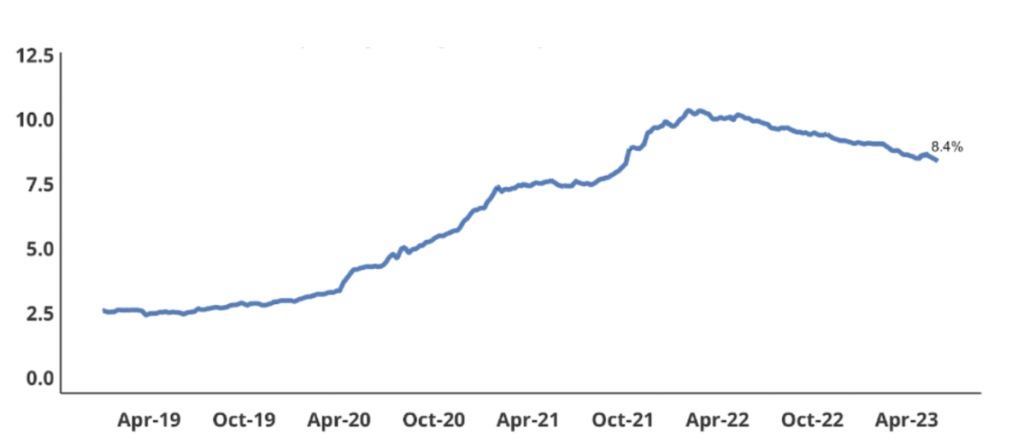
Digging into the data a bit deeper, it is evident that while overall remote work availability in the US may have declined since 2022, the sectors where it is already most prevalent are holding steady. Again, these are related to knowledge work. Specifically, the three job functions with the highest share of remote openings are all technology-related: software development, IT operations and helpdesk, and information design and documentation. As the data below show, the share of remote or hybrid job openings in these functions grew, although marginally, during the 12-month period of May 2022 – May 2023. In fact, other than marketing, this is true for all other functions where the share of remote work was already high.
Figure 5: Job Functions with the Highest Share of Hybrid or Fully Remote Openings - US
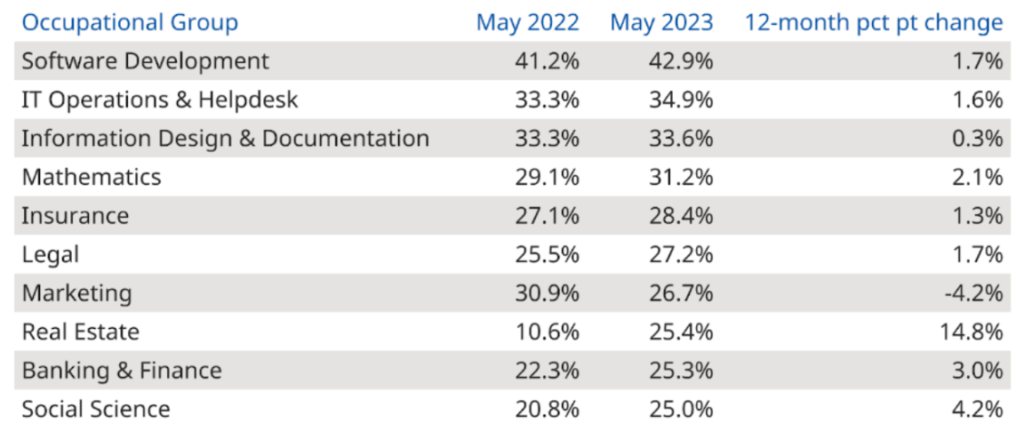
Conversely, the largest decline in this period was witnessed in the categories of human resources, marketing, and media and communications, where the share of remote openings was already much lower than in technology-related job roles. These patterns suggest that in the future, remote work is likely to persist in the latter category of jobs, where being physically present in an office is comparatively less important than in many other functions.
Figure 6: Job Functions with the Largest Increase and Decline in Share of Hybrid or Fully Remote Openings - US
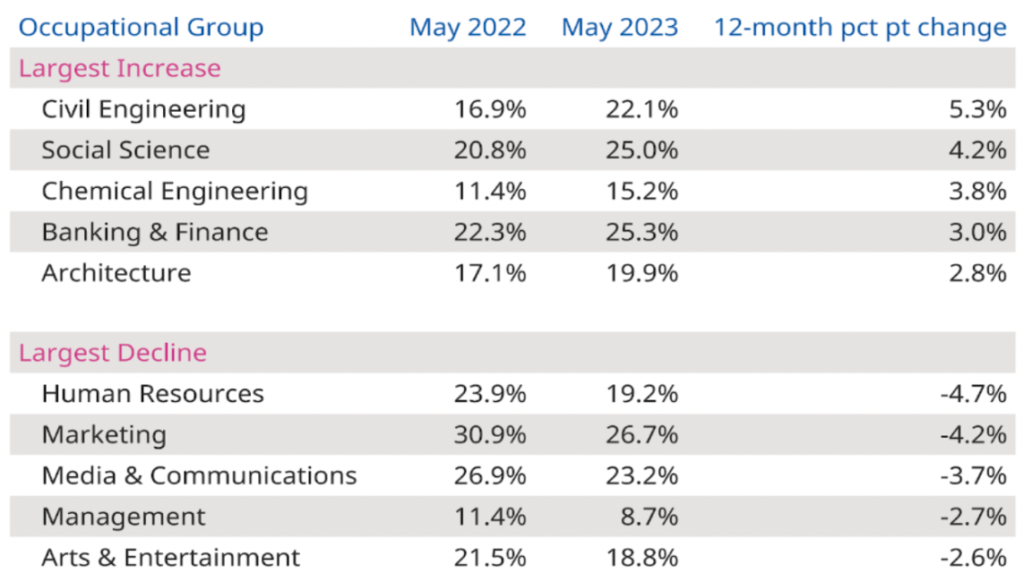
Europe
In Europe, the short term outlook for remote work is broadly the same, and if anything, a bit more optimistic compared to the US. The share of advertised remote or hybrid openings in the major economies of Europe – Germany, UK, and France – remains much higher than pre-pandemic levels. Although levelling out a bit in 2023, it has not declined since 2022 like in the US. In fact, in France the proportion of remote openings has risen sharply since mid-2022 and reached the US level, of around 8%. The share in the UK and Germany remains much higher, around 15%. These data support the earlier piece of research, showing that employers in Europe seem to offer more remote work than those in the US.
Figure 7: Share of Hybrid or Fully Remote Job Postings - Europe & US
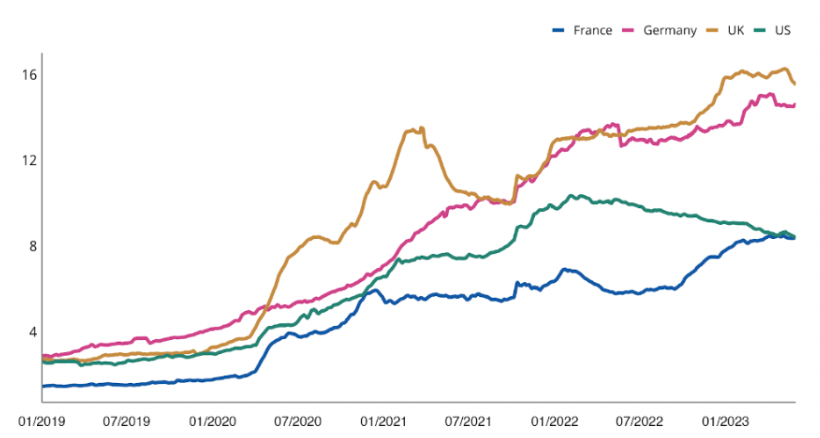
One possible explanation is that employees generally tend to have better bargaining power in Europe, compared to the US. However, other factors such as the make up of individual economies, the distribution of the population, and post-Covid business changes need to be taken into account for a more thorough comparative analysis. One point of similarity between the US and Europe is that the share of advertised remote or hybrid jobs in the technology-enabled functional area remains robust. As Figure 8 below shows, remote software development job postings have maintained their upward trajectory since the onset of the pandemic. As of May 2023, the highest share was in the UK, where exactly half of all software development job postings were remote or hybrid.
Figure 8: Share of Hybrid or Fully Remote Software Development Job Postings - Europe & US
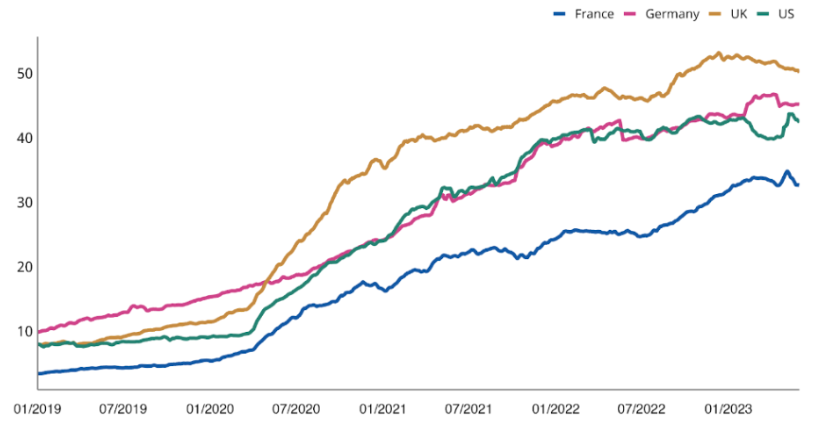
Australia
To round off the review of developed markets, a summary of the state of remote work in Australia is helpful. Here, too, the trend is very similar to the other markets. The share of remote or hybrid job openings has consistently risen, from around 4% at the end of 2019, to reach 12.6% by mid-2023. Furthermore, during the first half of 2023, insurance roles had the highest share of remote job postings, at 34.3%. This was followed by software development (33.1%), IT operations and help desk (31.6%), civil engineering (29.4%), and mathematics (29.0%). These results reinforce the common finding across the three regions that technology-related and knowledge work have the highest share of remote openings, which is likely to remain the case going forward.
Figure 9: Share of Hybrid or Fully Remote Job Postings - Australia
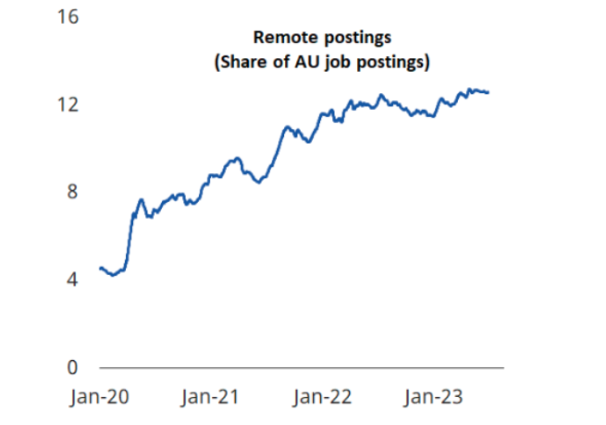
The future is hybrid and distributed
While the supply of remote work in general remains fairly strong for now, what kind of workplace will we see shaping up in the coming years? Some of the latest research tells us that most teams are probably not going to remain in the fully remote way of working from home adopted during the pandemic. Instead, a hybrid workplace is likely to become the norm, although that will depend on an organisation’s size and the industry it is in, amongst other factors.
Office attendance will not return to pre-pandemic levels anytime soon
The first piece of evidence is a study on the impact of the Covid-19 pandemic on the real estate market of some of the world’s biggest cities in six different countries, conducted by the consulting firm McKinsey & Company. Published in July this year, it estimates that office attendance has stabilised at around 70% of pre-pandemic levels. Furthermore, they project demand for office and retail space in the median city included in the study to be 13% lower in 2030 than it was in 2019. In a negative scenario, it could be 38% lower in the most adversely affected city.
Larger firms in the knowledge economy will offer more remote work
Another clear emerging pattern for the future is that contrary to some expectations, firms with larger employee headcounts are offering relatively more remote work. The McKinsey study found that of those surveyed, employees of firms with a headcount of more than 25,000 spent an average of 3.1 days in the office, progressing up to about 3.8 days for firms with 2-49 employees. The study also supported the finding discussed above, i.e. job functions related to information management, technology, and knowledge work generally being offered the most remote work. Of course, this may change in the future as economic and labour market conditions evolve. Nevertheless, as our recent analysis of the US and Australian economies showed, remote work does not seem to have hampered overall worker productivity.
Figure 10: Reported Number of Days per Week Worked in the Office

More hybrid, less fully remote
In March this year, the Pew Research Center published survey results on the state of work in the US, which showed that 35% of workers with jobs that can be done remotely were working from home all of the time, down from 43% in January 2022. However, the data also show that those working in a hybrid mode have increased, from 35% in January 2022 to 41% currently. On the one hand, these results show that after the pandemic, there was probably just a lower need for working from home the whole time. However, it also offers some evidence showing that remote working overall, irrespective of its frequency, has likely increased over the past year. This is consistent with the finding above showing a permanent dip in office space demand, as more hybrid work lowers the overall space requirement for firms.
Figure 11: Share of US Workers, Hybrid Versus Fully Remote
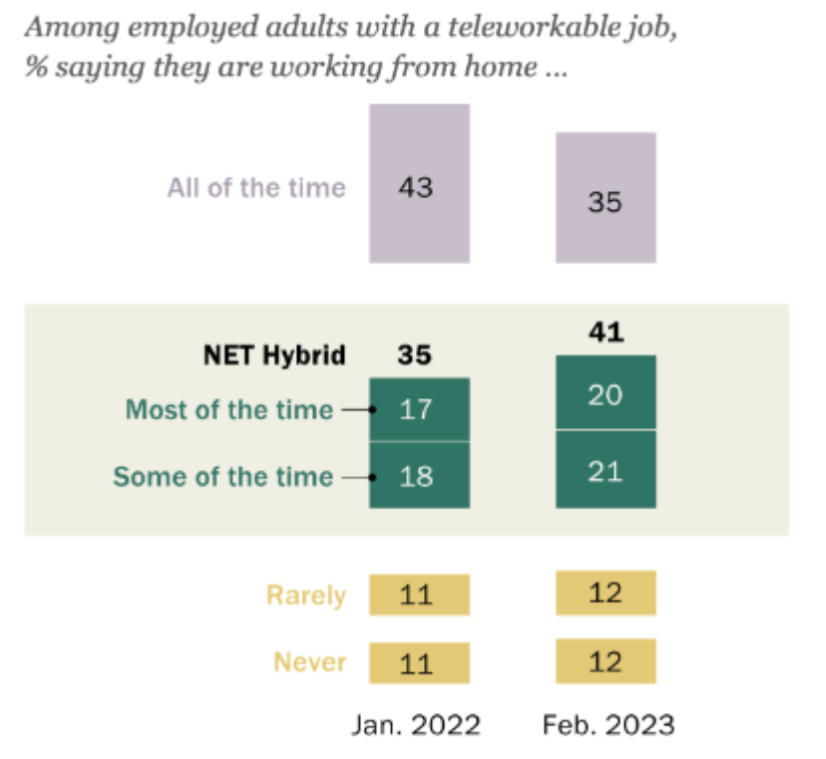
Workers’ expectations and urban demographics have significantly changed
Although the overall demand for remote jobs by workers remains high, two specific aspects are particularly noteworthy when looking towards the future. First, recent research by the European Central Bank shows that the preference for remote work remains highest in functions that are most easily performed that way, which also happen to be information and technology-related. This helps explain why the share of remote job openings in these functions remains high, as employers probably recognise the difficulty of attracting such skilled talent otherwise.
The second key change has been demographic. The McKinsey study cited above showed that there has been a significant outflow from the urban core areas in major global cities. For example, during 2020-22, New York City’s urban core lost 5% of its population while San Francisco lost 7%. With many of these professionals now living in suburban areas, where housing costs tend to be lower, there will be a natural resistance to returning. These findings also tend to corroborate the insights about lower post-pandemic office attendance rates, and suggest that the increase in hybrid work identified by the Pew Research Center will likely persist.
Individual firms will need to fine-tune their approach
At this stage, there is fairly robust evidence to support the expectation that remote and hybrid working models in information and technology-enabled job functions will persist in the coming years. On the whole, this will continue to provide flexibility to workers and firms alike, both of whom benefitted from the big remote work experiment during the pandemic.
However, there are caveats to this. To what extent, and how, remote work is integrated into its operations will depend on various firm characteristics, its broader strategies, and the make up of its staff. So even within the same industry, large variations can be expected. For instance, the NBER paper found that for management jobs, more than 50% of Being’s openings in 2022 were remote or hybrid, compared with virtually none in 2019. For SpaceX, also in the aerospace industry, the ratio remained near zero during this period. In insurance, Mutual of Omaha Company raised this ratio to 100% by 2022 from around 10% in 2019. On the other hand, Humana had a higher ratio than mutual in 2019, but by 2022 had only increased it to about 35%.
Finally, a key factor determining the shape of the future workplace will be the challenge of collaboration while working remotely, regardless of the nature of the job. Specifically, as our recent article explained, the costs of communication, collaboration, and coordination tend to be higher in a remote work environment. Companies will have to invest time and resources into this area to make remote or hybrid working as productive and meaningful as possible.









